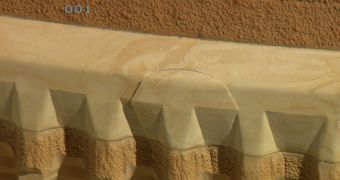Engineering teams working on a shuttle external fuel tank have found additional damage on the orange container, and are now considering all possible options for taking care of the problem so that the orbiter's schedule is respected.
The space shuttle Discovery was supposed to launch to the ISS on its final flight on November 1, but the take-off has suffered five consecutive delays, culminating with the last one, which saw the launch slip to November 30.
But now experts are unsure whether they will make the needed repairs in time. They say that the two new cracks were found in the insulation foam covering the external fuel tank, the massive assembly on which the shuttle and the twin solid rocket boosters (SRB) are attached.
Since work to repair the shuttle began, engineers discovered cracks in the foam insulation, in an assembly connecting the tank to the actual orbiter, and in the aluminum walls of the tank.
The shuttle was properly checked before being sent to the Launch Pad 39A facility at the Kennedy Space Center (KSC), in Florida, but mission scientists apparently missed several faults and glitches, including leaks in the engine and maneuvering pod departments, as well as electrical glitches in engine controllers.
Alarmed by the high frequency with which inspections revealed damages and problems with the shuttle, NASA decided to abort the launch for 24 days. The measure is meant to give repair crews the time they need to conduct extensive repairs, and patch things up when needed.
At this point, officials at the space agency still don't know if the newly-discovered crack can be repaired at the launch site, or if the shuttle will have to be brought back into the Vehicle Assembly Building (VAB).
“This is still really early on, so the exact repair method and schedule is still being figured out. It's just a matter of the repair method and how best to go about it. Right now, we're looking at repair options that can be done at the pad,” told reporters NASA spokesman Allard Beutel.
In the past, cuts in the external fuel tank's aluminum coating were repaired easily, by replacing the damaged section with other materials, and then replacing the foam on top. But this has never been done before launch.
Only personnel involved in the EFT production phase could do these modifications. It remains to be seen whether the American space agency will take the chance.
“We've seen these kinds of things before at the tops of stringers. They've done repairs to them before, but we've never done them here at Kennedy. They were always done at Michoud,” Beutel explains, quoted by Space.
But the Michoud plant has already fired many people, and more are due to be laid off next year. There is no way the EFT is going back there.

 14 DAY TRIAL //
14 DAY TRIAL //